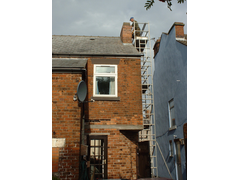

doing chimney

I have a chimney stack which has two unused pots (the fireplaces have been closed off and fitted with vents).
I was going to get up on the roof, remove the old post and cap them with a section of ridge tile to allow air flow but my wife saw a program on the TV
about falls rom roofs so now I've asked a local roofer to quote.
He came around this morning and has quoted £120 which doesn't seem bad but he wants to remove the pots, cover the holes with slate and then re-do
the flauncing so there would be no through ventilation.
I queried this but he said that's what they always do.
What do you think?
I believe you can get proper vents which look a bit like short chimney pots but these appear very expensive.
John.
Capped ours of with half a paving slab bedded on mortar and flaunched all round, there is another pot beside it for ventilation though. We were quoted
£95 about 10 years ago by the chimnrey sweep- I asked him what he'd do and then did it the next weekend, having humped a chunk of concrete up
the ladder I can see why you might just use a big slate!atb
Mike
You can buy 'caps' at builders merchants which fit over, and into, the chimney, with vents which allow it to breath.
I am a Chartered Surveyor, sounds like you would make a good surveyor too! You are dead right. The top of the flue should be vented but in a way which
prevents direct water penetration.
Your idea of a ridge tile over the flue is often used but the issue is to secure it so it doesn't fall off in a few years time giving you a nasty
bump on the head!
There are cowls which can be bought which look the same but are moulded to a short section of pipe which can be just set in the flue.
Hope this helps.
I reinstated a chimney last year which had been used for a gas fire with a diverter on top. I had to put a few layers of brick on then a couple of
pots one of which is partially blocked with a slate to allow ventilation and is only cosmetic but the other is for the fire. I had to rebuild the
feather inside as it was perished. If it's vented at the bottom it needs through draught but if it's blocked at the top it can be blocked at
the bottom as well. I was amazed at the number of wasps that kept flying down there while I was working on it.


doing chimney
Sorry Peteff, any disused flue should be ventilated. If not there is a risk of condensation that can break down the old mortar lining and then leach through to affect the plaster and decorations.
I kind of did mine in reverse... The fire place had been bricked up in the living room and a slab place on top of the chimney.
Near the top of the stack there was a clay air brick, seems to have done the job. I filled it with another brick, took the slab off the top, used
slate to mount a new pot on the top, then installed a log burner... 
I once capped one with an old dinner plate and some grip fill. It was a rented house and last time I drove past (admittedly a couple of years ago
now, but a good 7 or 8 since I did it) it was still up there.
Chris
Google hepworth fluevent as they have loads of options .
A cheap way of doing things which I don't really like doing but does work is by using a slate and piece of copper pipe.LOCOST
1 Cut a piece of slate the shape of the top of the chimney
2 what ever size of copper pipe you have drill a hole in the middle of the slate the same outer diameter of the pipe
3 using a pipe bender and bend it roughly to a shape of a walking stick
4 place pipe through slate long side down through the hole and seal with some appropriate sealant like ......sticks like $hit
5 seal slate down onto the top of the chimney with the same sealant
This will allow to cap the chimney and let any heat soak from down below condinsating and vent through the pipe.